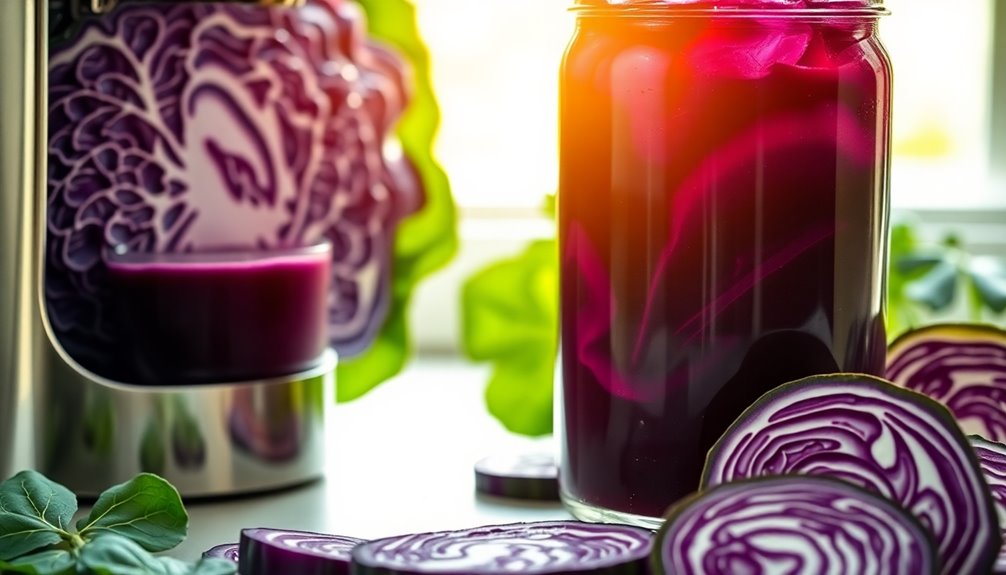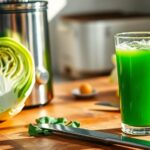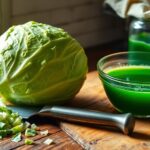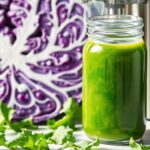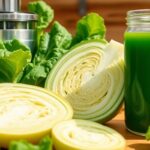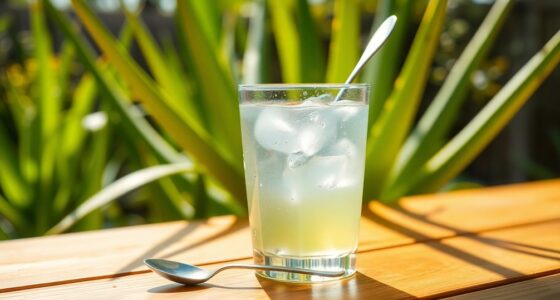To make cabbage juice, rinse and chop a head of cabbage, 4-6 stalks of celery, and 4 carrots into 1-inch pieces. Blend them with a splash of water for 1-2 minutes until smooth. Strain the mix through a mesh bag to separate the juice from pulp. For flavor, consider adding an apple, lemon, cucumber, or ginger. Drink it immediately for the best health benefits, and there's more exciting ways to enhance your cabbage juice!
Key Takeaways
- Rinse and chop cabbage, celery, and carrots into 1-inch pieces for juicing.
- Blend the chopped vegetables with a small dash of water for 1-2 minutes until smooth.
- Strain the blended mixture through a mesh bag to separate juice from pulp.
- Enhance flavor by adding optional ingredients like apple, lemon, cucumber, or ginger.
- Consume the juice immediately for maximum health benefits and freshness.
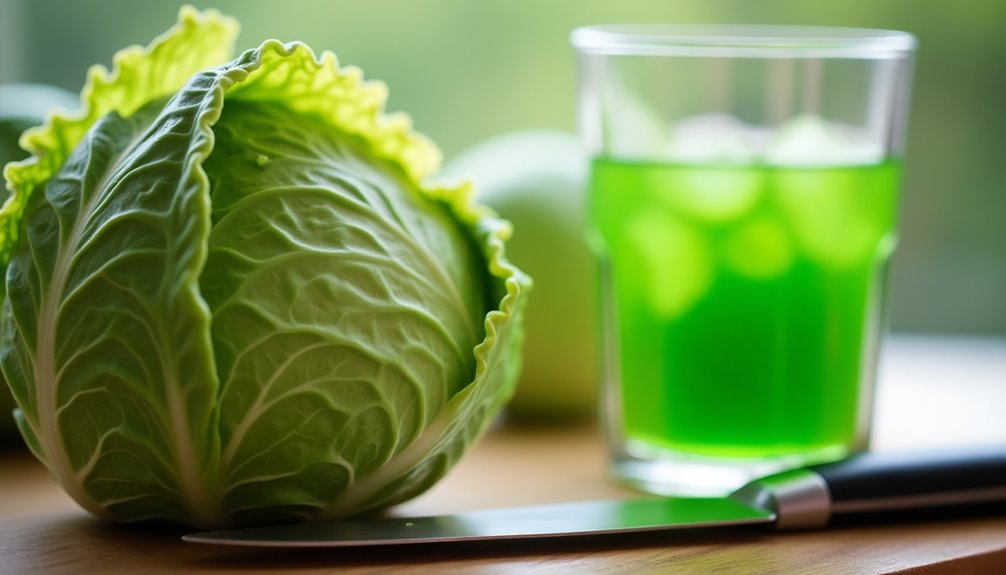
When you're looking for a nutritious boost, cabbage juice is a fantastic choice that's easy to make at home. Packed with essential nutrients, this vibrant drink can do wonders for your health, especially for your digestive system. Plus, it's simple to whip up, allowing you to enjoy the health benefits right away. So, let's dive into how you can make this refreshing juice using some straightforward cabbage juice recipes.
To start, gather your ingredients. You'll need one head of cabbage, 4-6 stalks of celery, and 4 carrots. Rinsing and chopping these vegetables into 1-inch pieces is essential for easy blending. If you're using a Blender, you might want to add a small dash of water to help with the blending process. Blend the mixture for about 1-2 minutes until it's smooth.
If you prefer a clearer juice, strain it through a mesh bag to separate the juice from the pulp. This method ensures you get the smoothest drink, which is best for your palate.
You can also mix cabbage with other ingredients to enhance the flavor and nutritional profile. For added sweetness, consider tossing in an apple. If you're after a bit of zing, a squeeze of lemon can do the trick. And don't forget about hydration; adding cucumber can give your juice a refreshing kick. You can also experiment with fresh ginger for a spicy twist that not only adds flavor but also provides additional health benefits. These combinations can elevate your drinking cabbage juice experience to a whole new level.
Freshly prepared cabbage juice should be consumed immediately for maximum health benefits. The nutrients, including vitamin C, are at their peak right after you make it. However, if you can't drink it all at once, store any leftover juice in an airtight container in the refrigerator. It's best consumed within 1-3 days to ensure you reap the most health benefits.
For those looking to boost their health, drinking cabbage juice can be incredibly therapeutic. Studies have shown that consuming 8 oz. of cabbage juice 1-4 times daily may aid in healing ulcers within approximately nine days. This powerful vegetable isn't only a tasty addition to your diet but also a natural remedy for various ailments.
Incorporating cabbage juice into your routine can be a simple yet effective way to improve your overall well-being. Whether you're looking to enhance your gut health or just enjoy a delicious drink, making cabbage juice at home is an easy and rewarding choice. So, roll up your sleeves, grab your Blender, and start mixing cabbage for a delightful, health-boosting juice today!
Frequently Asked Questions
How to Make Juice of Cabbage?
To make juice from cabbage, start by rinsing and chopping a head of cabbage into chunks.
You can add other ingredients like celery, carrots, or even an apple for extra flavor.
Blend the chopped veggies with a bit of water until smooth.
If you're using a blender, strain the mix through a mesh bag to separate the juice from the pulp.
Enjoy your fresh juice immediately for the best taste and health benefits!
Is It Good to Drink Cabbage Juice Everyday?
Did you know that drinking cabbage juice daily can potentially help heal peptic ulcers in just about nine days?
It's definitely good for you, packed with vitamins and compounds that boost gut health and reduce inflammation.
If you gradually introduce it into your diet, you can enjoy its benefits without discomfort.
Just remember, it's wise to consult a healthcare provider before making it a regular part of your routine, especially if you have digestive issues.
How to Make Cabbage Juice Without a Juicer?
If you want to make cabbage juice without a juicer, start by rinsing and chopping a head of cabbage into 1-inch pieces.
Toss the pieces into a blender and add a bit of filtered water to help with blending. Blend on high for 1-2 minutes until it's liquid-like.
Then, strain the mixture through a nut milk bag or fine mesh sieve to separate the juice from the pulp.
Enjoy your fresh juice!
Can You Juice Cabbage Raw?
Yes, you can juice cabbage raw! It keeps all the nutrients and enzymes intact, making it a healthy choice.
When you pick your cabbage, choose fresh, firm heads without any mushy spots for the best flavor.
If you don't have a juicer, you can use a blender, just add some water and strain the mixture afterward.
Conclusion
Now that you’ve mastered the art of cabbage juice making, you’re practically a culinary wizard! With every sip, you’re not just drinking juice; you’re sipping on a potion that could make you feel like you can conquer the world! Who knew this humble vegetable could turn you into a superhero of health? So, grab that juicer, channel your inner green machine, and let the vibrant power of cabbage juice elevate your day to epic proportions! As you blend the vibrant power of cabbage juice with other nutrient-packed ingredients, don’t forget to explore the onion juice health benefits that can complement your concoction perfectly. This dynamic duo can boost your immune system and enhance your overall vitality. So, get creative in the kitchen, and let your culinary adventures lead you to new horizons of wellness!
Cindy thoroughly researches juicing trends, techniques, and recipes to provide readers with practical advice and inspiration. Her writing style is accessible, engaging, and designed to make complex concepts easy to understand. Cindy’s dedication to promoting the advantages of juicing shines through her work, empowering readers to make positive changes in their lives through the simple act of juicing.

